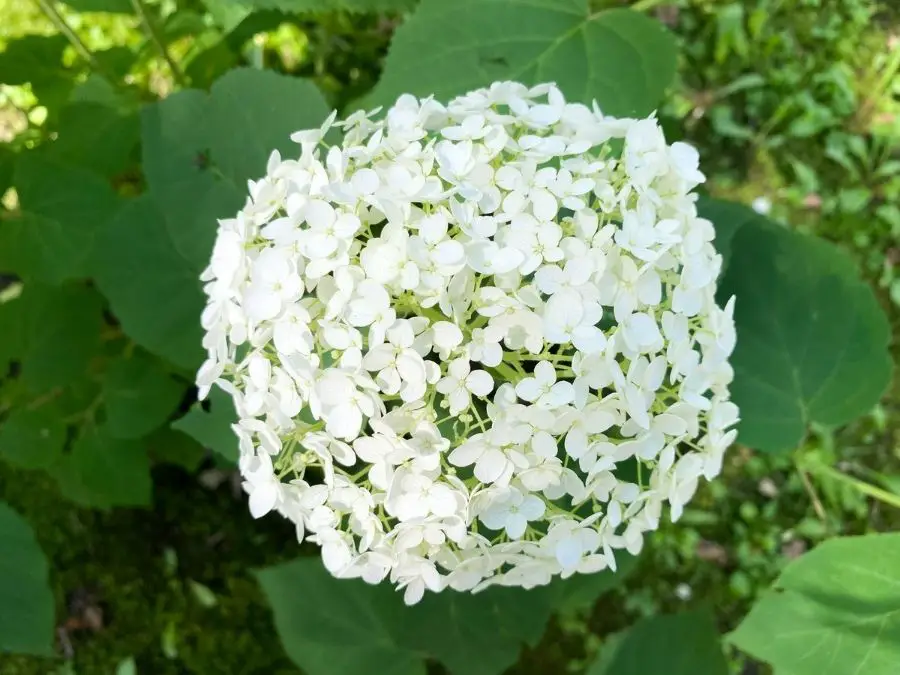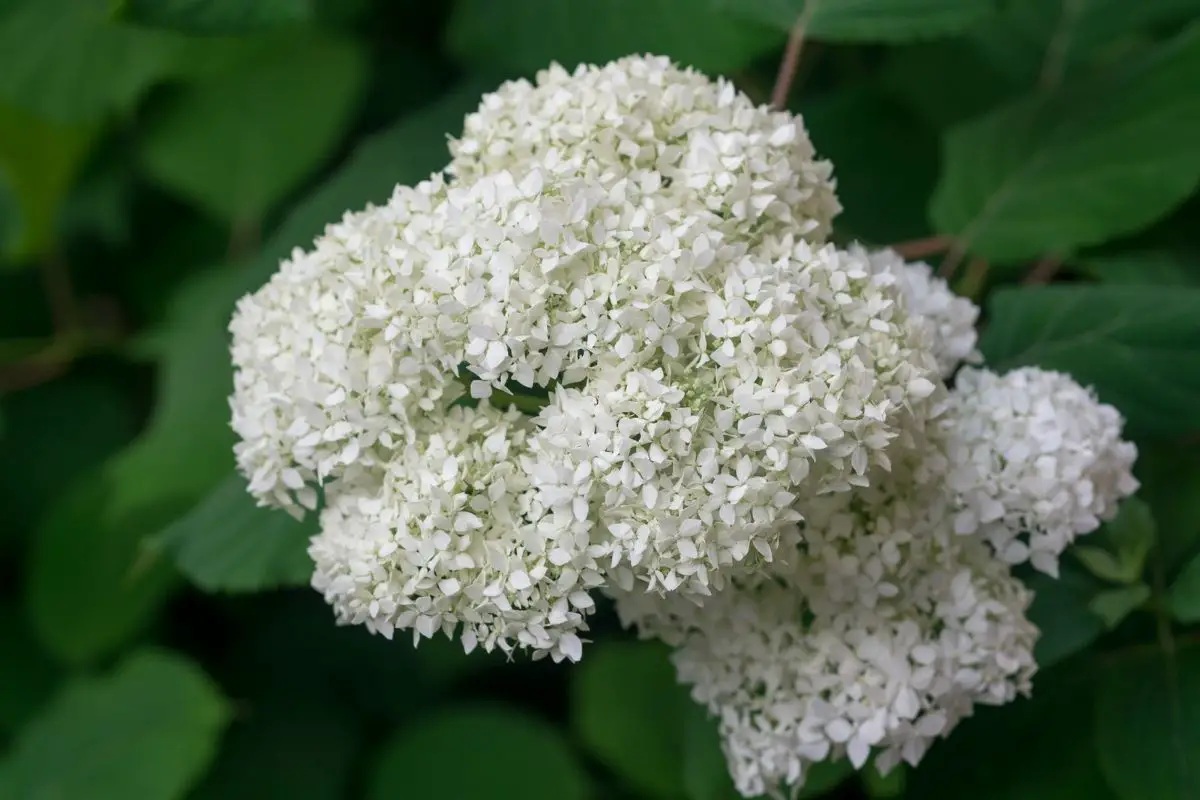The Hydrangea arborescens, commonly known as smooth hydrangea and wild hydrangea, is a lovely shrub that has enormous creamy, white flowers in early summer. It is perennial, deciduous, and grows in USDA zones 3 to 9.
This variety of hydrangea has large serrated leaves and its bark can peel off in successive layers in winter, giving rise to its colloquial name “Sevenbark”.
History
Smooth hydrangea is native to the southeastern United States, where it grows wild. Cultivation of this shrub started in the mid-1700s in America and by the late 1700s, it was introduced to and bred in Europe.
Its name, Hydrangea arborescens, derives from the Latin word for tree “arbor” because this shrub can resemble a tree when it’s growing.
Plant Facts
| Scientific name | Hydrangea arborescens |
| Common names | Smooth leaf hydrangea, wild hydrangea, sevenbark |
| Genus | Hydrangea |
| Family | Hydrangeaceae |
| Height | 3 to 5 feet |
| Width | 3to 5 feet |
| USDA Plant Hardiness Zone | 3 – 9 |
| Origin | United States |
| Flower colors | Green, white, cream, brown |
| Blooming season | Late spring and early summer |
| Plant/Flower special features | Hardy, tough but not drought tolerant |

How to Plant and Grow Hydrangea arborescens
A smooth leaf or wild hydrangea can make a useful addition to a shrubbery or perennial border. It can be planted at the back of a border or made into a specimen tree as a decorative, growing feature.
This variety of hydrangea shrub is not drought tolerant and does not do well if it is planted in full sun or is left to dry out. Because of this, it is probably not a good choice if you are looking for a hydrangea to grow in a container.
H. arborescens grows wild in the southeastern United States and is cold hardy from zones 3 to 9. It should be planted in a spot that receives the morning sun but is sheltered from the heat of the afternoon sun.
When you have found a good planting spot, enrich the soil if necessary. The most important determinant is that the soil is well-drained, slightly acidic, and moist.
Once you have planted the wild hydrangeas, you should water the ground around the hole well. Afterward, you should water during dry periods because this shrub does not cope well with drought conditions.

Care and Maintenance
All hydrangea bush varieties are easy to care for, and the smooth hydrangeas are no exception. An occasional trim and keeping it watered during dry weather is all that is necessary.
Soil
The most important requirement is that the soil is well-drained and not soggy. It should however be moist and slightly acidic. If necessary, add some compost to enrich the soil before planting.
Water
This is a hydrangea that needs regular watering. It doesn’t survive drought conditions for an extended period. Like all varieties of hydrangea, the smooth-leaved hydrangea should not sit in waterlogged soil, or it will rot and die.
Fertilizer
This is a white flowering hydrangea; it is not possible to alter its color by changing the acidity of the soil or by the use of low phosphate fertilizer.
The best time to apply fertilizer is in the early spring. The fertilizer should be slow-release and with a universal type of composition. This application will encourage strong, healthy roots and new growth.
Sunlight
H. arborescens needs sun to flower well, but it should be morning sun only. Lack of enough sunshine will cause hydrangeas not blooming. Don’t plant in a spot that gets the afternoon sun, as it will get too hot and won’t do well.
Temperature and Humidity
Smooth-leaved hydrangeas are cold-hardy in USDA zones 3 to 9. They won’t do well if they are planted in full sun or a very hot location. Moisture is important and in dry weather, you should water the plant regularly, making sure it doesn’t sit for extended periods in wet soil.
Pruning
This hydrangea shrub, which grows wild in southeastern America, can become rather straggly and untidy. It doesn’t grow particularly tall but will spread to around 5 feet in width. You may wish to trim it to maintain its pretty rounded shape. You can cut the hydrangea bush back hard and close to the ground in late winter, and it will benefit greatly from this.
Unlike bigleaf hydrangeas, the smooth-leaved hydrangea, H. arborescens, flowers on new wood. You can prune this plant in winter or even early spring, as it will have time to produce new growth and blossom by the summer.
How to Propagate Wild Hydrangea
You can propagate this hydrangea bush by layering or by taking stem cuttings in the spring. Layering is an easy and effective method where there are low-lying branches that can be pegged into the ground, covered with a little compost, and left until they have formed small roots after a couple of months.
Pest and diseases
There aren’t many problems that are faced by this hydrangea shrub. If you do encounter small insects on your plant, then you can often wash them off with a powerful jet from a garden hose. If the problem is particularly severe, you can use a spray bottle filled with a diluted soapy solution to remove them.
The most common problem affecting smooth hydrangeas is caused by fungal diseases such as Botrytis, blight, or mildew. Fungicide sprays are available, but all diseased leaves, flowers, and flower buds must be removed and destroyed. Otherwise, the spores from the fungi will spread to healthy plant tissue and infect that too.
Uses of Smooth-leaved Hydrangea
H. arborescens is a good choice for a garden where you want the seeds to attract birds, and the flowers to attract butterflies and other pollinators.
Because it doesn’t grow too tall, it can even find a suitable place in a smaller garden as it can be trimmed to control its spread.
Common Varieties and Cultivars
The most commonly available cultivar is H. arborescens ‘Annabelle’. It produces a showy spectacle of large, round flower heads, sometimes over ten inches in diameter.
The flowers produced are sterile, which results in a consistent flower shape and color.
Another cultivar, known as “Grandiflora” also produces a beautiful display of large, snowball-like flowers.
Conclusion
A smooth hydrangea bush offers you a plant that is easy to care for, winter hardy, and that has beautiful flowers that look like snowballs during the summer.
~ image source: depositphotos/aga77ta&yarm.sasha

